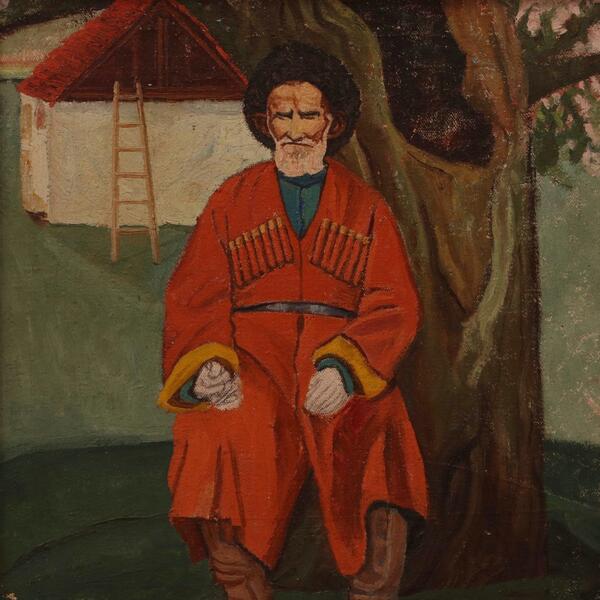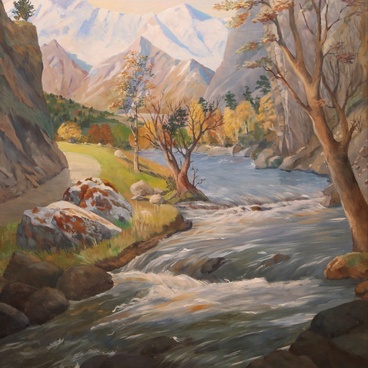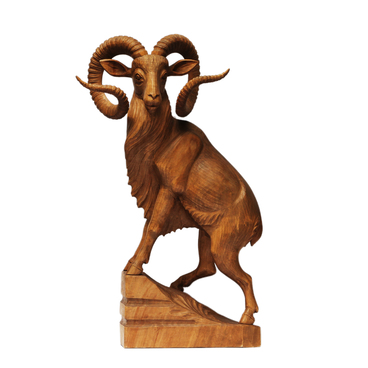Khasolt Akiev is not only a prominent painter, but also a historian. He defended his thesis ‘The Peoples of the Northern Caucasus in the Russo-Turkish War of 1877-78’ and for a long time headed the Ingush Scientific Research Institute named after Chakh Akhriev.
He enjoyed studying the history of the establishment of Soviet power in Ingushetia. Akiev worked in archives for a long time and discovered some interesting documents about the participants of the Civil War of 1917-1923. He was inspired to create this portrait by one of the heroes of those years.
The war between the White and the Red Army directly affected Ingushetia: the highlanders believed in the ideals of Bolshevism and stood up for the revolutionaries. Guerrilla groups started to appear everywhere.
In those years Sergo Ordzhonikidze, an extraordinary commissar of southern Russia, arrived in Ingushetia. The revolutionary led the war against the troops of Anton Denikin, one of the commanders of the White Army.
The pro-tsarist White Army forces tried to suppress the resistance. They set a reward of 1.5 million gold rubles for the life of Ordzhonikidze. But the Ingush people stood up for him: the residents of the villages of Muzhichi and Dattykh hid the revolutionary.
Yusup Khakiev, a civil war veteran and resident of the village of Muzhichi, is depicted by an old hollow tree. He was a comrade-in-arms of Ordzhonikidze and let him stay in his own house, in which the commissar set up a headquarters and directed the guerrillas' actions.
According to a story told by Yusup Khakiev, when the White Army tried to find their enemy, the elder hid Ordzhonikidze in a hollow of an old tree and later led him to safety through mountain trails.
The artist wanted to remind younger generations of the courage of their countryman. He portrayed the man capable of self-sacrifice next to a tree with a hollow opening. At first glance, the hero seems to be just an old man resting in his yard. But if one looks closely, one can sense a completely different mood of his posture. Yusup Khakiev is collected and calm, his eyebrows are sternly pulled together. Here he is — a revolutionary ready to defend his ideals till the end.
The artist focused on conveying the expression of the hero’s face. He tried to depict every wrinkle. The surrounding landscape was painted in a generalized manner: the sunlit meadow is painted simply in two colors, and here and there one can see the canvas itself showing through. The man’s Circassian coat and boots are also painted with a few brush strokes: rigid outlines indicating the folds of his costume are clearly visible. The artist even left the man’s hands unfinished — just outlined the position of his fingers. This is how the artist highlighted the main point of the painting: the very nature of Yusup Khakiev — the firmness of his will.
He enjoyed studying the history of the establishment of Soviet power in Ingushetia. Akiev worked in archives for a long time and discovered some interesting documents about the participants of the Civil War of 1917-1923. He was inspired to create this portrait by one of the heroes of those years.
The war between the White and the Red Army directly affected Ingushetia: the highlanders believed in the ideals of Bolshevism and stood up for the revolutionaries. Guerrilla groups started to appear everywhere.
In those years Sergo Ordzhonikidze, an extraordinary commissar of southern Russia, arrived in Ingushetia. The revolutionary led the war against the troops of Anton Denikin, one of the commanders of the White Army.
The pro-tsarist White Army forces tried to suppress the resistance. They set a reward of 1.5 million gold rubles for the life of Ordzhonikidze. But the Ingush people stood up for him: the residents of the villages of Muzhichi and Dattykh hid the revolutionary.
Yusup Khakiev, a civil war veteran and resident of the village of Muzhichi, is depicted by an old hollow tree. He was a comrade-in-arms of Ordzhonikidze and let him stay in his own house, in which the commissar set up a headquarters and directed the guerrillas' actions.
According to a story told by Yusup Khakiev, when the White Army tried to find their enemy, the elder hid Ordzhonikidze in a hollow of an old tree and later led him to safety through mountain trails.
The artist wanted to remind younger generations of the courage of their countryman. He portrayed the man capable of self-sacrifice next to a tree with a hollow opening. At first glance, the hero seems to be just an old man resting in his yard. But if one looks closely, one can sense a completely different mood of his posture. Yusup Khakiev is collected and calm, his eyebrows are sternly pulled together. Here he is — a revolutionary ready to defend his ideals till the end.
The artist focused on conveying the expression of the hero’s face. He tried to depict every wrinkle. The surrounding landscape was painted in a generalized manner: the sunlit meadow is painted simply in two colors, and here and there one can see the canvas itself showing through. The man’s Circassian coat and boots are also painted with a few brush strokes: rigid outlines indicating the folds of his costume are clearly visible. The artist even left the man’s hands unfinished — just outlined the position of his fingers. This is how the artist highlighted the main point of the painting: the very nature of Yusup Khakiev — the firmness of his will.



